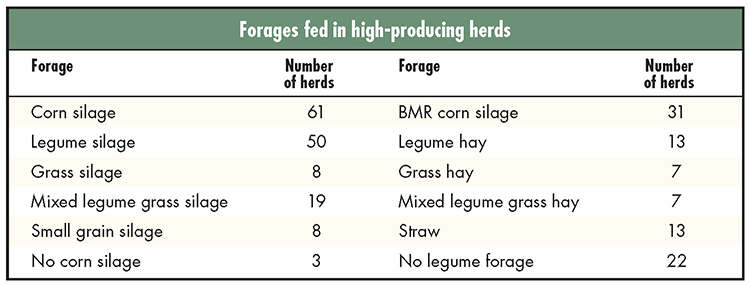A trend toward more forage and milk |
| By Larry Chase |
|
|
|
The author is an emeritus professor of dairy nutrition with Cornell University. Forages are the foundation of nutritionally sound and rumen healthy rations. The quality and quantity of forages fed are related to milk production, purchased feed costs, whole farm nutrient balance, and profitability. Forages are usually the most economical sources of energy, protein, and fiber in dairy rations. The industry trend is for a greater proportion of forage in the total ration, while at the same time, milk production per cow has continued to climb. Researchers at the University of Wisconsin surveyed the feeding programs of seven high-producing Holstein herds in 1995. These herds had an average milk production of 28,912 pounds of milk per lactation. The average forage inclusion was 44% of the total ration dry matter with a range of 36% to 55%. Six of the herds used alfalfa silage as the primary forage in the ration. Two herds fed no corn silage. Total ration neutral detergent fiber (NDF) averaged 27.3% with a range of 24.7% to 30%. Times have changed In 2019, we put together a set of 79 rations in high-producing herds. This was a survey, and herd information was provided by feed companies and nutrition consultants. Since there were several ration formulation programs used, all rations were evaluated using the Cornell Net Carbohydrate and Protein System (CNCPS) model to provide a common base for ration evaluation. There were 26 rations from herds feeding one ration to all their milking cows. In the other 53 herds, a high-group ration was used. Model-predicted energy-corrected milk production averaged 110 pounds per cow per day. These herds were primarily from the Northeast and Midwest regions, but three herds from Israel were also included. Key findings from this survey included:
 Why more forage? There are several factors that contribute to the fact that dairy herd milk production has increased even with higher amounts of forage being fed. These include: • Improved forage genetics: There have been significant improvements in forage digestibility and yield. The change in digestibility translates to higher dry matter intake and milk production. • Improved forage practices: Dairy producers have made many changes in crop rotations, forage hybrid and variety selection, soil testing, fertilization, and harvest and storage management. The result is higher yields of forage per acre. • Greater use of forage testing: Forage testing labs continue to offer new analyses that better predict the value of forage in the ration. The availability and use of NDF digestibility have been a major contributor to the increase in ration forage levels. • Ration formulation programs: These programs continue to add new nutritional concepts that better predict the use of forages and feeds in rations. The ability to incorporate forage digestibility information in these programs permits higher levels of forage to be used. • Forage storage and allocation: It is more common to store forages by quality. This provides the opportunity to better match forage quality to animal needs. • Cows have changed: Dairy cows today are bigger than 15 to 20 years ago. This has resulted in greater rumen capacity and higher dry matter intakes. When combined with improved fiber digestibility, this allows cows to consume more feed and assists in using higher ration forage levels. Herds feeding higher forage rations are more common. These herds use several types of forages in the rations. A common thread through all herds is the use of higher quality forages. The choice of which forage(s) to produce on a specific farm depends on factors such as soil type, crop rotation, and nutrient management considerations. The quality of the forage is more important in determining potential milk production than forage type. This article appeared in the January 2021 issue of Hay & Forage Grower on page 12. Not a subscriber? Click to get the print magazine |
